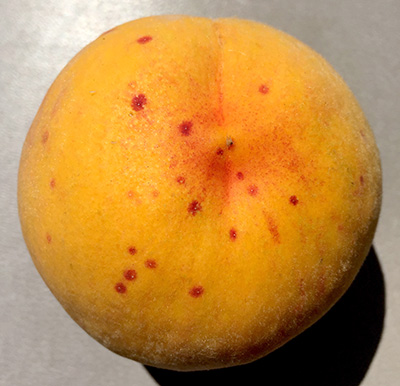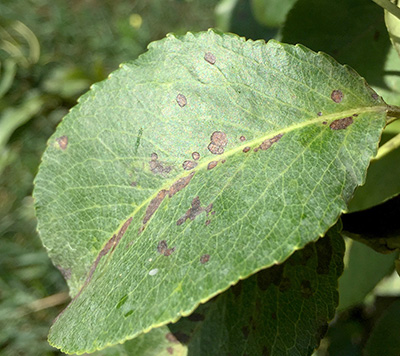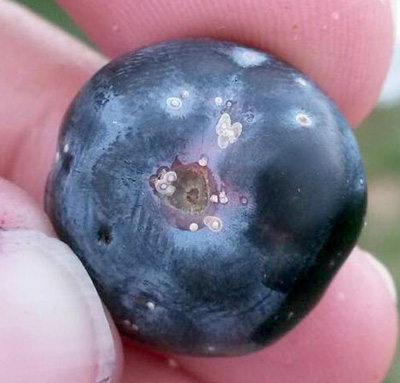Southwest Michigan fruit regional report – July 26, 2016
Blueberry and peach harvest are in full swing. Spotted wing Drosophila numbers are up as the fly is coming off wild fruit.

Weather
Last week was hot with high temperatures near 90. The overnight lows were in the 60s and average temperatures were in the mid- to upper 70s. Several rain events moved through the region last week on Monday, and Thursday and Sunday brought thunderstorms across the region. These storms brought varying amounts of needed rain. Most areas received more than 2 inches of rain for the week. Rainfall totals for the season vary from 9 to 18.5 inches with most Michigan State University Enviro-weather stations averaging a little over 10 inches of rain since April 1.
High humidity is causing evapotranspiration rates to be about a fifth of an inch of water a day. Soils are moist. Our daily heat accumulations were similar to last week’s with 34 growing degree-days (GDD) base 42, 31 GDD base 45 and 26.5 GDD base 50.
The upcoming week will continue to be hot. High temperatures will be in the upper 80s. There is a good chance of thunderstorms on Thursday, July 28. Unsettled hot, humid weather with a chance of thunderstorms is on tap for the end of the week.
Southwest Michigan GDD summary from Jan. 1 through July 24, 2016 | |||
|---|---|---|---|
|
Station |
GDD 42 F |
GDD 45 F |
GDD 50 F |
|
Benton Harbor (SWMRC) |
2660 |
2303 |
1776 |
|
Lawton (Lawton) |
2656 |
2295 |
1758 |
|
Fennville (TNRC) |
2323 |
1989 |
1490 |
|
Average for the region |
2483 |
2136 |
1622 |
|
Accumulation last week |
241 |
220 |
185 |
Tree fruit
Last week’s rain restored the soil moisture levels and relieved drought stress on young orchards. Trap catch numbers for oriental fruit moth remain high. This is the third week of the second generation flight of this pest. Second generation codling moth should be emerging soon. Codling moth trap catch numbers are generally low, but some orchards saw an increase last week. Obliquebanded leafroller trap catch numbers are low, but we should see an increase soon as the second flight should begin soon. San Jose scale male trap counts have increased starting about mid-July for the second generation flight. Red markings from new scales made by crawlers are appearing on fruit. A third generation of this insect appears in early September.

The red spots on this peach are caused by San Jose scale. This red mark is a common symptom of peaches, plums and apples when scale settle on the fruit. Photo: Bill Shane, MSU Extension.
Trap catches of adult lesser peachtree borer and greater peachtree borer are continuing in low numbers. Potato leafhopper burn is showing up in apples. Yellowing alfalfa fields indicate this pest is common in the area. Scout fruit plantings close to woods and riparian areas periodically for brown marmorated stink bug infestations. We are trapping nymphs and adult brown marmorated stink bugs are low. Numbers should increase in late August to early September. We are catching more spotted wing Drosophila (SWD) in southwest Michigan. Trap numbers are rising and we catching over 100 SWD in some traps. Dry conditions encourage birds to forage in fruit and bird peck damage is common on fruit varieties that develop early red blush.
Apricot harvest is ending. Weather conditions have been good for red skin color and fruit flavor. The dry conditions have been good for suppressing brown rot and bacterial spot.
Peach harvest of Garnet Beauty, Risingstar and Summer Serenade is ongoing with PF Lucky 13 and PF14NJ to start later this week in central Berrien County. See “2016 Michigan peach harvest date prediction” from MSU Extension for more on predicted peach harvest dates. Oriental fruit moth trap catches continue for the second generation flight. Oriental fruit moth larvae are easy to find in peach fruit and branch terminal tips in some orchards. Some control problems may be due to using pyrethroid insecticides that tend to break down more quickly during hot weather.
New leaf drop due to bacterial spot has declined with the dry weather. Brown rot control programs should rotate among the different classes of fungicides to stave off resistance problems. Save the most effective fungicides for when fruit are coloring and most susceptible to infection. Bird pecks in the fruit serve as easy infection points for brown rot.
Cherry leaves need to be protected from cherry leaf spot. Because of the dry conditions this spring, cherry leaf spot is just beginning to establish in area orchards. Chlorothalonil is excellent for cherry leaf spot after harvest. Copper can be used for cherry leaf spot control on tart cherries, but is phytotoxic to sweet cherry leaves. Growers can do modest pruning in cherries after harvest as late as early September.
Plum harvest is underway. Shiro harvest will begin soon. Intensify brown rot spray programs as fruit start to color and ripen. Fruit left on the tree until soft are more susceptible to SWD infestation.
Apple estimated harvest dates are available from MSU Enviro-weather for weather stations across Michigan. In central Berrien County, Aug. 30 is the predicted harvest date for McIntosh, Sept. 16 for Jonathan and Sept. 22 for Red Delicious. Harvest is about five to 10 days later in the Allegan County region. Retain applications are targeted for 30 days before expected harvest. The time for Retain application is quickly approaching. Red strain gala varieties are developing red blush. Fruit sizes range from 2-3 inches.
Fruit entry stings from codling moth or oriental fruit moth have been found in several area orchards. Second generation codling moth should be emerging soon, some orchards saw an increase last week. Obliquebanded leafroller trap catch numbers continue to be low, but the second flight is due. Apple maggot should emerge in good numbers following last week’s rains and growers should be sure they are covered. Sooty blotch and flyspeck disease symptoms should be appearing soon. A general rule of thumb is reapply fungicides for these diseases after an additional 220 hours of leaf wetness, or 2 inches of rain has occurred following application.
Pear fruit range from 2 to 2.25 inches in diameter. Fabraea leaf spot symptoms are common on leaves and fruit of some varieties. Fungicides applied for pear scab in June and July will generally control this disease. Some orchards have sticky leaves due to pear psylla honeydew.

Fabraea leaf spot on pear. Photo: Bill Shane, MSU Extension.
Small fruit
Spotted wing drosophila (SWD) numbers are up in southwest Michigan (see “Michigan spotted wing Drosophila report for July 22, 2016”). We are catching SWD in almost all of our traps. We are seeing a surge in numbers as SWD come off ripening wild fruit such as black raspberries and blackberries. Some traps had over 100 flies in a week. Growers with ripe fruit should be protecting against this pest now. We typically see SWD numbers surging at the end of July to very high levels. Japanese beetles are easier to find. Numbers should increase after Sunday’s widespread rains.
Juice grapes are approaching bunch closure. Vinifera grapes are also sizing rapidly in the recent heat. The fruit are now resistant to new infections of black rot, powdery mildew, downy mildew and phomopsis, but infections of the rachis can still form in some wine grape varieties. Growers will now focus on protecting against downy and powdery mildew infections on leaves; risk for downy mildew infection will increase when morning dews begin to form in August.
A few grape leafhoppers and potato leafhoppers have been found in area vineyards. Growers will be scouting for these pests. Japanese beetles have emerged and are feeding in hotspots. Dates for full bloom in wild grape were May 28 for Berrien County and May 30 for Van Buren County. Use these dates grape berry moth Enviro-weather model to predict third generation egglaying. The control window for third generation flight is predicted to begin July 30 near Benton Harbor, July 31 near Lawton and Aug. 2 near Berrien Springs. There will likely be a fourth generation of berry moth this year.
Blueberry harvest continues. Fruit quality and size has been good, but the lack of harvest labor is a problem. Growers are machine-harvesting Jersey, the major mid-season variety. Hand and machine harvest of Bluecrop continues. Growers are finishing harvesting Duke and other early season varieties.
SWD numbers are increasing across the region and growers need to protect their fields. Growers scrambled to reapply insecticides to protect SWD after Sunday’s heavy rains. We are seeing a surge in flies coming off wild fruit. See MSU’s current recommendations for SWD control in blueberries.
Putnum scale has been found on fruit. Heavy use of pyrethroids to control SWD can cause flare-ups of secondary pests, such as scale or mites, which are normally not a problem. Growers should rotate their spray materials to different chemical classes to avoid problems from the overuse of one type of insecticide. Blueberry maggots are easy to find in unsprayed fields. Blueberry maggots should not be a problem in fields sprayed regularly for SWD.

Putnum scale on blueberry fruit. A few growers reported tiny, white spots on blueberry fruit. At this time in the season, no treatment is effective and the insect will not spread any further. Photo: Mark Longstroth, MSU Extension.
Anthracnose is the most common fruit rot found in harvested fruit. Systemic fungicides applied before irrigations can effectively prevent fruit rot. Fungicides applied after infections are not as effective in controlling this disease in ripening fruit. Use the Anthracnose Enviro-weather model. Phomopsis stem canker collapse is not a big problem this year. Growers should pay close attention to soil moisture and irrigate to maintain good fruit growth.
Growers should protect newly emerging strawberry leaves from potato leafhoppers and leaf diseases. Growers should irrigate under these hot and dry conditions to maintain good plant growth and a good crop next year. Growers with day-neutral strawberries should consider monitoring or treating for SWD.
Bramble harvest is ending for summer red raspberries. Blackberry harvest is underway. Growers should be irrigating. Raspberries and blackberries are shallow rooted and suffer under dry conditions. Ripening fruit is very attractive to SWD. Growers should have traps on their farms. Some growers are picking every two days to avoid SWD. For more information, see MSU’s current recommendations for SWD control in raspberries and blackberries.
See also:
- Michigan spotted wing Drosophila report for July 22, 2016
- Watering fruit trees with micro-irrigation systems
- 2016 Michigan peach harvest date prediction
- SDHI fungicides for protecting fruit from brown rot infection
- Predicted 2016 apple harvest dates
- Summer leafroller control
- Irrigating Michigan blueberries
- Control of pre- and post-harvest fruit rots in blueberries
- Use anthracnose fruit rot prediction model to assess risk of infection.



 Print
Print Email
Email




